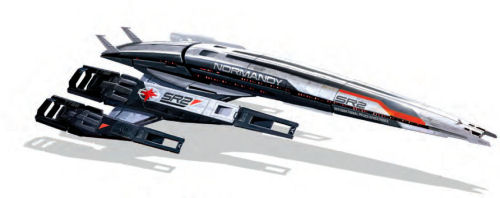LAST EDITED ON Apr-04-10 AT 03:40 AM (EDT)
Babylon Project Galactic Database
Text Data Extraction Search: Jane's Fighting Starships
Search criteria: IPS Normandy
SEARCH COMPLETE: APRIL 4, 2410
IPO photo by Chad Collier
IPS Normandy
(SR2)
Overview
IPS Normandy is an experimental starship combining elements of the International Police Space Force's Next Generation Warship program with tried-and-true Salusian shipbuilding techniques, intended to fill a niche left unaddressed by the Defiant and Steamrunner classes.
Name/Model: Normandy class (Mark II)
Manufacturer: Royal Saenar Fleet Systems, Ltd.
Combat designation: Stealth reconnaissance frigate (SR)
Entered service: Expected June 2410
Crew: 40
Length: 720 ft.
Mass: 275 Kt
Power system: International Police Yards microsingularity core
RSFS Mark LXXVI fusion reactor
Propulsion system: IPY Tantalus Mk IV gravity gradient drive
4x RSFS Mark XCVII fusion impulse thrusters
Speed rating: 100 MGLT
Flight control system: IP Tech Div/Haanatuvu Meltrandi Arsenal Inertia Vector® maneuver system
Maneuver rating: 50 DPF
Navigation: British-AnimeTech Model 2195 superluminal isolinear computer core
FTL: IPY Tantalus Mk IV gravity gradient drive
Warp speed rating (cruise): Warp Factor 10
Warp speed rating (flank): Warp Factor 15.75
Secondary FTP: RSFS Mark MXCV motivator drive unit (hyperdrive)
Hyperdrive rating: .4
Shields: QuarTech Cyclonic Barrier® multicore projective deflector shield system
Shield rating: [CLASSIFIED]
Armor: Stark Industries Silaris® carbon/alloy composite plating
Armor rating: [CLASSIFIED]
ARMAMENT
Fixed armaments: Palaven Heavy Industries Thanix Magnetohydrodynamic Weapon
2x WDF Armory G-950 multifocal phaser arrays
2x WDF Armory P-112 point phaser arrays
Expendable armaments: 2x WDF Armory Mk VII photon torpedo launchers
AEROSPACE COMPLEMENT
ExoSalusia UT-47 Kodiak drop shuttle
TACTICAL COMPLEMENT
ExoSalusia M35 Mako cavalry fighting vehicle
Ares Corporation Landmaster hostile environment exploration vehicle
History
In 2275, the Wedge Defense Force requested proposals a new type of light starship. The operating spec for the vessel called for a ship no bigger than 500 feet long, utilizing the latest starship automation technologies to reduce the required crew size as much as possible, and equipped with the Internal Emission Sink passive stealth system originally developed at Utopia Planitia Naval Shipyard for the Royal Salusian Navy's Barghest-class destroyers. The new ships were intended to supplement, and if successful eventually replace, the active-stealth Vigil-class scouts then employed by the WDF's Reconnaissance Command, as part of a planned force buildup that would have seen the WDF expand to a full fleet-level operation by the year 2310.
The winning proposal, filed by the firm of Royal Saenar Fleet Systems, Ltd., of Salusia, led to the commissioning in 2280 of a prototype vessel, WDF Normandy (SR-1), which was put in the hands of Commander Virginia E. Shepard for an exhaustive practical testing period. The experimental ship performed well in trials, and the WDF was prepared to order further examples and begin the fleet expansion program when the organization disbanded following the coordinated GENOM Corporation attack codenamed Operation Götterdämmerung. The Normandy was destroyed in that attack.
In 2406, Commander Shepard joined the International Police Organization as one of the Experts of Justice. (How she survived the Normandy's destruction and where she's been since are not matters of public record.) Over the next several years, she searched the galaxy for surviving members of the Normandy's crew, assembling them (and a few new people she recruited along the way) into a Special Assignment team. By 2408, it had become clear that she would require a larger starship than the CR90-class corvette she'd been using in order to provide the team with a proper mobile base of operations.
IPO Chief Benjamin Hutchins considered several options, including assigning Shepard to the command of a Defiant- or Steamrunner-class destroyer detached into the Space Force's Irregular Projects Division, before settling on the construction of a wholly new vessel, tailored specifically to the strengths and talents of Shepard and her team. Since the IP Yards and their prime contractor, Kanzaki Heavy Industries of Ishiyama, were both working to capacity building the Next Generation Destroyers and developing Project Surprise, the job went to the WDF Normandy's builders, Royal Saenar.
RSFS's engineers dusted off the 2280 Normandy spec documents and revised them heavily, with a good deal of technological cross-pollination from the DDNG projects and Royal Saenar's other IPSF contract, the refurbishment of the spacecraft carrier Prometheus, then well underway. The result was a vessel that was roughly 50% larger than the original and different in many respects, but with an instantly recognizable common profile. Other names were considered for the new class, including Kadesh, Zeta Cygni, and Elysium, but in the end sentimentality prevailed and the new ship was named, like the original, Normandy.
ANALYSIS
IPS Normandy SR2 represents a fusion of tried-and-true Salusian shipwrighting principles and the Zetan overtechnologies developed for the IPO's Next Generation Warship initiative, along with several newly developed systems sourced from the IPO's technological development arm and several of its partners around the galaxy. Fast, maneuverable, and heavily armed for her size, the Normandy possesses excellent passive stealth capabilities thanks to her Internal Emission Sink system and experimental gravity-gradient drive technology.
The Tantalus gravity gradient drive system is the centerpiece of the Normandy's arrangement of beyond-bleeding-edge technologies. It's a multifunction system that manipulates gravitation to produce several different effects. In one mode, it can be used for sublight maneuvering by creating gravity vectors the vessel "falls" toward, enabling the Normandy to move without using her conventional fusion drive thrusters, which would tend to spoil the

 Printer-friendly copy
Printer-friendly copy





